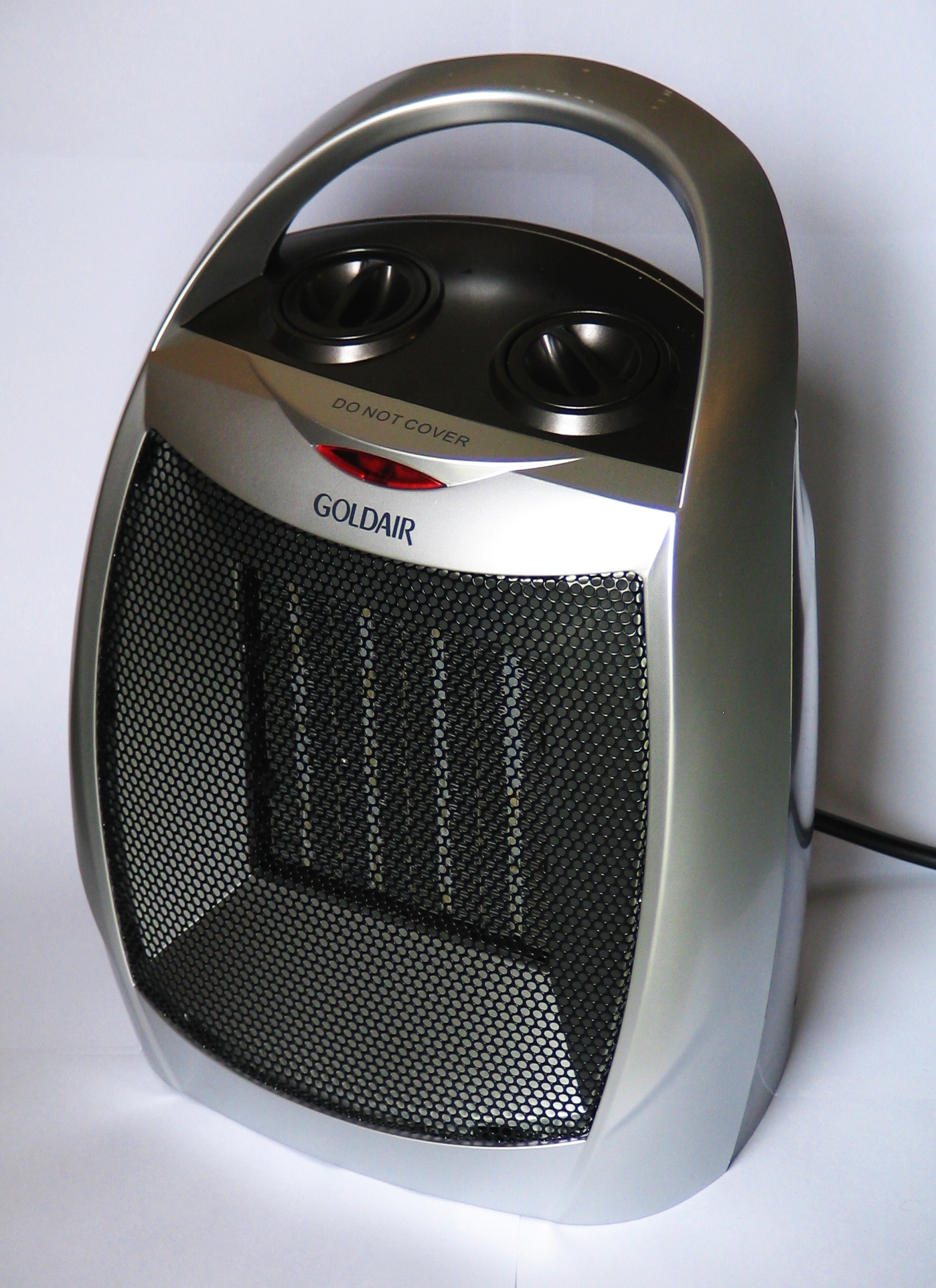Ceramic heater on:
[Wikipedia]
[Google]
[Amazon]
 A ceramic heater as a consumer product is a
A ceramic heater as a consumer product is a
 A ceramic heater as a consumer product is a
A ceramic heater as a consumer product is a space heater
A space heater is a device used to heat a single, small- to medium-sized area. This type of heater can be contrasted with central heating, which distributes heat to multiple areas.
Types
Dominant mode of heat transfer
All space heaters t ...
that generates heat using a heating element
A heating element is a device used for conversion of electric energy into heat, consisting of a heating resistor and accessories. Heat is generated by the passage of electric current through a resistor through a process known as Joule heating. He ...
of ceramic with a positive temperature coefficient (PTC). Ceramic heaters are usually portable and typically used for heating a room or small office, and are of similar utility to metal-element fan heater
A fan heater, also called a blow heater, is a heating, ventilation, and air conditioning#Heating, heater that works by using a fan (machine), fan to pass air over a heat source (e.g. a heating element). This heats up the air, which then leave ...
s.
Heating principle
PTC ceramic material is semi-conductive and whenvoltage
Voltage, also known as (electrical) potential difference, electric pressure, or electric tension, is the difference in electric potential between two points. In a Electrostatics, static electric field, it corresponds to the Work (electrical), ...
is applied to it, the power decreases quickly as it reaches a certain temperature according to the particular composition of the ceramic. The ceramic elements are in contact with aluminium fins, thereby heating the fins. A fan blows air across the fins, cooling the fins as they heat the air.
Differences from other electric heaters
Electricheating element
A heating element is a device used for conversion of electric energy into heat, consisting of a heating resistor and accessories. Heat is generated by the passage of electric current through a resistor through a process known as Joule heating. He ...
s made of resistance wire
Resistance wire is wire intended for making electrical resistors (which are used to control the amount of current in a circuit). It is better if the alloy used has a high resistivity, since a shorter wire can then be used. In many situations, the ...
also have a positive temperature coefficient of resistivity
Electrical resistivity (also called volume resistivity or specific electrical resistance) is a fundamental specific property of a material that measures its electrical resistance or how strongly it resists electric current. A low resistivity i ...
, but do not increase their resistance enough to be self-regulating; they are typically used with the wires red-hot. The ceramic, on the other hand, increases its resistance sharply at the Curie temperature
In physics and materials science, the Curie temperature (''T''C), or Curie point, is the temperature above which certain materials lose their permanent magnetic properties, which can (in most cases) be replaced by induced magnetism. The Curie ...
s of the crystalline components, typically 120 degrees Celsius
The degree Celsius is the unit of temperature on the Celsius temperature scale "Celsius temperature scale, also called centigrade temperature scale, scale based on 0 ° for the melting point of water and 100 ° for the boiling point ...
, and remains below 200 degrees Celsius, providing a significant safety advantage. Ceramic heaters also have thermostats which switch power to the PTC array on and off in response to the temperature of the room, like other types of heater.
History
Heater vendors first offered ceramic heaters in 1986. By 1989, approximately twenty percent of portable household heaters sold in the USA were ceramic heaters.Heating elements
Ceramic fin is one type of heating element used in heaters. These units contain a solid block of ceramic material with metal fins attached. An electric current heats the block, which in turn heats the fins. The fins then heat the air. In another type of heating element, the honeycomb disk, the block of ceramic is perforated with numerous holes. The air is heated as it flows through the holes. No fins are required for honeycomb disk heating elements.Criticism
In the 1980s, some manufacturers were making advertising claims that critics such as New York Times writer Matthew L. Wald found dubious. In particular, manufacturers claimed ceramic heaters produced more heat than conventional ones, even when both were rated with the same heat output.Consumers Union
A consumer is a person or a group who intends to order, or use purchased goods, products, or services primarily for personal, social, family, household and similar needs, who is not directly related to entrepreneurial or business activities. Th ...
has not found significant differences between ceramic and conventional heaters. However, in its 1989 review, the testing organization did treat ceramic heaters as a separate category, as a response to manufacturer claims. The only significant difference it found was ceramic heaters were substantially more expensive. As a category, the conventional heaters it tested that year slightly outperformed ceramic heaters in the areas of evenly heating all parts of a room and at holding the room at a steady temperature. Consumers Union did find ceramic heaters' characteristic of sharply reducing heat output when airflow was blocked to be a useful safety feature. However, it found that the tip-over switches and overheat-protection sensors included in many conventional heaters also provided good safety.
References
{{HVAC Heaters